
 |
|
|
#31 |
|
Arms Historian
Join Date: Dec 2004
Location: Route 66
Posts: 10,670
|
This thread is fascinating!!! and although considerably outside my usual field or range of study, the topic is widely applied to virtually all forms of ethnographic weapons, as Jens has very aptly noted. As he suggests, material culture often survives and as we know is collected, with the motif and symbolic decoration losing the original meaning as the items leave thier original environment.
I think it is great to see the outstanding knowledge shared here working together to develop plausible and likely explanations concerning this example and the topic overall. It is exciting to learn more on this as it certainly is beneficial to incorporate the same perspective and theories in all aspects and theaters of ethnographic weapons study! As an admittedly 'untrained' eye on Moro weapons, I would like to nonetheless suggest that to me the motif seems to overall follow the contour of the blade, and the outside or border motif does seem decorative in its linear and repetitive form. The figures within the border however do seem to reflect some symbolic possibility, with some possibility of anthromorphic forms as has been mentioned. It does seem to me that the semicircular motif in the 'border' may have, as suggested, nagan connotation. I very much look forward to any response on these views, as well as the development of this discussion as I would like to learn more on the symbolism of these weapons. Its great to broaden horizons!!  Thanks very much guys!! All the best, Jim |
|
|

|
|
|
#32 |
|
Member
Join Date: Dec 2004
Location: What is still UK
Posts: 5,925
|
Looking in a few books on the art of regions surrounding and relevant to this sword. I think it may not be too far fetched to see the design as a stylisation of a Naga/Dragon which is indeed common to this part of the world. It may be so stylised to be inoffensive to a more strict Muslim environment. This dramatic stylisation of fantastic beasts and sky motiffs is common in other Islamic art forms. Most easily brought to mind is the carpet, incompassing much Islamic design. I will try and add more after my tea.
Last edited by Tim Simmons; 29th January 2007 at 07:41 PM. |
|
|

|
|
|
#33 |
|
Member
Join Date: Dec 2004
Location: What is still UK
Posts: 5,925
|
This design on the sword may be even more simple and obvious if you are a practicing Muslim or rather one familiar with the Islamic artistic cosmology. I am most certainly not. However one could see the design in two parts. The swirly part nearest the tip is a cloud which symbolises the sky, the portal to heaven. Heaven being one of several layers of gates in the celestial world. After heaven there is another portal the sun gate the divine light and leading to the throne of god.
The part nearest the hilt that I suggested was a dragon may still be so. But I now think it is most likely a representation of Eden. What I saw as scales though upside down, is the land/earth and from that the strange pattern is the garden of exotic flowers. These elements of Islamic iconography are not hard to find or I could have just lost my marbles   . .post script. The centre or field of a this Kashmir carpet/prayer rug illustrates this quite well but there is a lot more room for the designer to explain themselves. The clouds are cearly seen outside the dome {mirhab} the garden in this case a tree and known in the carpet world as the tree of life. 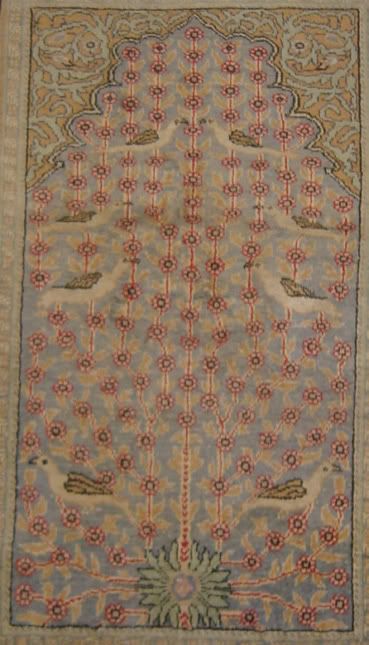
Last edited by Tim Simmons; 29th January 2007 at 08:48 PM. |
|
|

|
|
|
#34 |
|
EAAF Staff
Join Date: Dec 2004
Location: Louisville, KY
Posts: 7,345
|
Never thought of that......something to consider.

|
|
|

|
|
|
#35 |
|
Member
Join Date: Dec 2004
Posts: 951
|
Hi Tim It s nice the tree of life but is it talismanic does it brings you power in a battle .
That s what I don t think so I don t think it is talasmanic but maybe I am wrong so I like to know Ben |
|
|

|
|
|
#36 |
|
Member
Join Date: Dec 2004
Location: What is still UK
Posts: 5,925
|
Battle and paradise have been linked by many people and cultures throughout history. To me this imagery on an Islamic weapon is pretty much the same as a sacred heart or other device/talisman on a European saber. The imagery fits the concept of cultural belief. I believe to be killed in battle, the warrior goes straight to paradise/heaven.
Last edited by Tim Simmons; 30th January 2007 at 11:44 AM. |
|
|

|
|
|
#37 |
|
Member
Join Date: Dec 2004
Location: Sweden
Posts: 1,637
|
The tree of life/central pillar/axis mundi is a very important both archaic and universal symbol for comparing different religions according to the leading authority within this field - Mircea Eliade. In short it's the center of the world, the connection point between the heaven (where "the Sacred" reside), the earth (humans) and often the underworld. Compare Jacob's ladder, Gunungan etc.
Seeing the scales/eggs as clouds, symbolising heaven, is maybe a key to this riddle? On the "figures" inbetween an interpretation could be that they somehow represents something dualistic, like + - + -. To have an idea what it could be of course you have to know more about the local myths and beliefs than I do at the moment. Maybe if somebody knows something about local creation myths a theory could be developed? An example could be if f.i. at the time of creation some divine force created two men and two females from where all humans origin? Not knowing if this is the case a hypothesis of this inlay as talismanic could be: At the base of the Kris (heaven, the Sacred?) is something of a "battery/power source" that transmits some kind of energy (the + - + -). This energy is transformed into a (earth - vegetative, creative) force (birth-life-death) that is pointed at an enemy in battle to powercharge this Kris. If the + - + - represents male and female ancestors then we have a metaphysical "nuclear missile launcher"?  Michael Last edited by VVV; 30th January 2007 at 09:34 AM. |
|
|

|
|
|
#38 |
|
Member
Join Date: Dec 2004
Location: What is still UK
Posts: 5,925
|
The scales/eggs are the garden of Eden/paradise and the clouds the sky and gateway to the divine light and throne of god.
I am turning into a carpet salesman  . They do help explain Islamic iconography. With this Turkish example the same message is behind a much more formal arrangement. The garden/paradise is a single plant in a pedestal bowl. Kashmir to Turkey is nearly as far as Kashmir to PI echoing the spread of Islam. I bet if members look they will see more of this stylised motif on other weapons. . They do help explain Islamic iconography. With this Turkish example the same message is behind a much more formal arrangement. The garden/paradise is a single plant in a pedestal bowl. Kashmir to Turkey is nearly as far as Kashmir to PI echoing the spread of Islam. I bet if members look they will see more of this stylised motif on other weapons.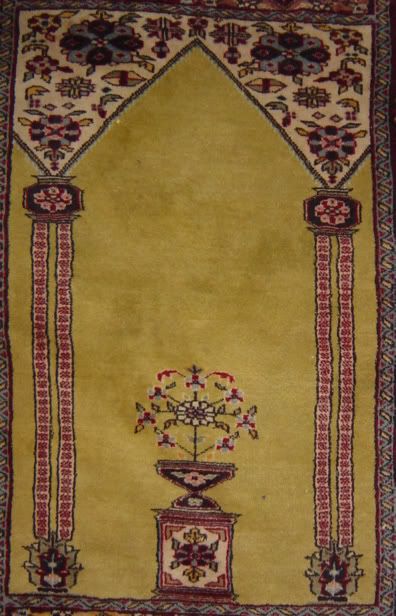
|
|
|

|
|
|
#39 |
|
Member
Join Date: Dec 2004
Location: Sweden
Posts: 1,637
|
Tim,
As you have noticed I got inspired by your tree of life interpretation of the inlay. But I am more hesitant to the "backwards symbolism" of sending yourself to heaven from earth with the help of this sword. I find it more probable that the owner wished to survive and the sword to send the opponent to hell instead.  From what little I have been exposed to Filipino culture I have seen more of positive thinking than negative thinking of the outcome of battles. In the case of Juramentado I have the impression that the blades they used were not as expensive and high status like this? Michael |
|
|

|
|
|
#40 |
|
Member
Join Date: Dec 2004
Location: What is still UK
Posts: 5,925
|
I am sure it would be a positive thing. like all mottoes on weapons. God is always on your side.

Last edited by Tim Simmons; 30th January 2007 at 08:02 PM. Reason: spelling |
|
|

|
|
|
#41 |
|
Member
Join Date: Dec 2004
Location: What is still UK
Posts: 5,925
|
Honest. I post this one from Afghanistan to show how stylised these can get. So the images on the blade are relatively conservative.

|
|
|

|
|
|
#42 |
|
Member
Join Date: Jan 2006
Location: Kent
Posts: 2,658
|
I appreciate that sometimes I have some 'wacky' ideas....but if we all thought the same way....progress in knowledge would be greatly slowed. (well that's my excuse anyway
  ) but I'd like to throw this idea into the discussion. ) but I'd like to throw this idea into the discussion.The phallic symbolism of the sword has been shown to be relevant to many cultures and time periods..... Could it be that the 'clouds' indeed symbolises 'heaven' , the repetative side motif symbolising 'life' (if it is a form of flora ) but, shaped in a phallic design (the 'bringer' of life? Male virility?). The 'rising' symbols perhaps representative of male, female (human seed? re-incarnated souls?). The Sword itself, is the 'bringer' of death, in combination with the 'life' symbolism, we end up with a depiction of the cycle of life........birth (re-birth?) , growth and death. .........and afterall 'The pen_is mightier than the sword'...   Interesting thread, iconography, symbolism etc is an important part in the study of ethnographic weaponary. If we could 'crack' the lost meanings ...we would get 'more of a feel' of how these items were viewed through the 'eyes' of their original owners. |
|
|

|
|
|
#43 |
|
Member
Join Date: Dec 2004
Location: What is still UK
Posts: 5,925
|
The Mosque as an image is not unknown on carpets, sorry to labour this aspect but they do give a wonderful resource. I could see a column of people prone at prayer which would be very unorthodox and a fantastic example of a PI twist to an Islamic motif. The image carried on a blade as this is the tropics, sheep are not kept so the carpet tradition and artistic expession does not exist in PI.
|
|
|

|
|
|
#44 |
|
Member
Join Date: Dec 2004
Location: What is still UK
Posts: 5,925
|
I wonder if we see the same thing on this middle eastern knife. This knife is no longer mine. Although possibly a little more simple it is quite a formal pattern with some similarity to the Turkish design.
http://www.vikingsword.com/vb/showth...t=balkan+knife |
|
|

|
|
|
#45 | |
|
Member
Join Date: Dec 2004
Location: Sweden
Posts: 1,637
|
Quote:
At least one myth in Indonesia mentions this aspect as well as the old connection between Keris and Shivaism. Michael |
|
|
|

|
|
|
#46 |
|
Member
Join Date: Mar 2005
Location: USA Georgia
Posts: 1,599
|
Hmm, it seems that we are looking at symbols from a culture that was originally Negrito, animistic then with an Islamic veneer, over this older animistic culture.
We have two main avenues of possibilities. Interpret in terms of that particular society and interpret in terms of universal symbols. Interpretations in terms of a societal arena posits certain questions. First, how many people in any culture truly understand in depth, the symbols of their OWN culture? And of those people, how many are willing to talk about those symbols? If they do talk, how much is intentional or accidental misinformation. In "Shields of Melanesia" (2006) Ed Harry Beran and Barry Craig, the author remarks that he has often asked about a design on a new Guinea shield. Often he was told, “We merely follow what our ancestors have done.” When he asked about a certain symbol on a shield, they said, “the v-shape represents the beak of the hornbill.” This could represent the way the hornbill beak looks from straight ahead as seen by the young hornbill when he is being fed through an opening in the tree trunk. Maybe this could be on the back of the shield to strengthen and protect the bearer. This could fit in 'local legends' Melanesia or in Borneo. The Dayak believe that the hornbill is a divine messenger. Maybe the V could represent the hornbill telling a Dayak a message from the high kingdom. BUT unless you take the time to learn about a specific culture you will have an impossible time learning the symbolism that appears on weapons or other artifacts. Continuing in “Shields of Melanesia,” the author continues to ponder the problem of understanding a culture by observation and logic. He uses the metaphor of an Martian anthropologist lands lands on earth. He begins to quiz people on the street of a modern industrial society about the meaning of the overall design of an automobile. He would be told, “it does not represent anything. It evolved from carts pulled by horses. It is merely designed to transport people and goods." But the Martian might ask deeper questions. Why does it have two headlights? Do they represent eyes? Maybe a talisman that looks ahead for the protection and safety of the driver? The grill looks like a mouth. Is this to threaten other drivers that your vehicle might attack and eat them? I have left the book a few sentences back and now forge ahead on my own. The three pointed star on the hood ornament (Mercedes) does this represent the Trinity (Father, Son and Holy Spirit of the Christian religion? The Trimurti (Shiva, Vishnu and Brahma)? The high world, the middle world and the lower world, always keeping them in mind as you go forth? Do the hubcaps represent shields? They have 12 divisions. Does that correspond to your Zodiac? They are removable, do you use them for personal defense? As thrown weapons? The patterns in your upholstery. They look vegetative. Do they represent the eggs and flowers of Creation? Is your exhaust a dragon simile? Now I would suspect it would get even more complicated and possibly if our Martian was using his own culture as a basis. So where does that leave us in the study of a design on an artifact created as an Islamic overlay on an animistic folk magic culture? Can logic lead anywhere productive? I think it does if you approach these symbols from a more universal standpoint. Let the logic lead to a visceral response. What do they mean to you? Shiva’s Trident? Neptune’s Trident? Naga eggs? Clouds? Flowers? Do they evoke a feeling in you, the viewer? Then that is exactly what they mean. What did they mean to the guy who put them there? I sincerely doubt anyone, even his wife, will ever know. I believe it was Jung who suggested that instead of analyzing the dream, analyze the dreamer. If this strikes a chord in someone here – other than just thinking this reply is the ramblings of a bemused dreamer, myself, we can take this further. Where do symbols come from? Why do we use them? Why are we drawn to them? Why are the religious systems of EVERY culture riddled with paradoxes? |
|
|

|
|
|
#47 |
|
Member
Join Date: Dec 2004
Location: What is still UK
Posts: 5,925
|
Interesting points Bill. I am inclined to feel that we can look at these not as an absolute alien. We do have some well known facts about the people thier religion and lives. I am dreaming too, but a local version linked to a pan Islamic influence is a viable area to investigate. Looking for a source is possibly a first step. Scholars managed to interpret ancient Egyptian hieroglyphics and much middle American writing systems. If other members had more to compere might be helpful.
|
|
|

|
|
|
#48 | |
|
Member
Join Date: Mar 2005
Location: USA Georgia
Posts: 1,599
|
Quote:
Hi Tim, I believe the hieroglyphics were basically untranslateable until someone discovered the Rosetta stone that had the royal and heavenly (Egyptian) languages along with the same information in classical Greek. Even then it took about 20 years, after it was discovered, (early 1800s) for a translation to be availaible. Comparative translation of this artifact originally created in about 200 bc did then lead to the understanding of previously untranslatable heiroglyphic texts. The text of the Rosetta Stone is a decree from Ptolemy V, describing the repealing of various taxes and instructions to erect statues in temples. I don't necessarily see a correlation here. Best I can tell the early animistic cultures, whether Philippines or elsewhere had no written language. I would like to belive that I coulld look at these animistic cultures with a better understanding, but I have friends who have been there and studied primitive cultures and they have told me there is an alien-ness that they never felt they ever understood. Even in the works of Margaret Mead, there is confusion. Still we can glean information from their works and hopefully enjoy a glimmer of understanding. We do the best we can. For now, I can see agreement with every interpretation in this thread on Michael's exceptional kris. All have validity. Personally it looks like a protective enclosure focusing some energy down the blade. |
|
|
|

|
|
|
#49 |
|
Member
Join Date: Dec 2004
Location: Sweden
Posts: 1,637
|
Bill,
Thanks for your interesting posts. One thing that puzzles me is the Negrito connection? As far as I understand the "Moros" are of Malay-Indonesian origin and not related to the original "Negritos" living before them on the islands? Another influence, especially important related to Kris culture and Folk Islam, is the pre-Islamic Hindu beliefs in this area. Also there exist some early documentation to be found on the beliefs in the area from the time before this Kris was produced. On the two avenues it's a classical clash of two schools (f.i. within your field of comparative religion); - all symbols are universal (Eliade, Jung), and - all symbols are specific to the local culture (Evans-Pritchard, Geertz). As usual with two extremes "the truth" is often found somewhere inbetween. I really enjoyed your Martian example but if the Martian had read about the earthlings before his field work probably he had drawn less drastic conclusions? I fully agree with you on: "Still we can glean information from their works and hopefully enjoy a glimmer of understanding." That's exactly the purpose of this thread. We can probably never find out for sure the exact meaning of this motif. But together maybe we can find some possible explanations of it? The alternative is to dismiss it as all guess work, which in a way it of course is. But that doesn't increase the possibility of understanding on how to get closer to some of the more probable meanings of this riddle. Michael |
|
|

|
|
|
#50 |
|
Member
Join Date: Dec 2004
Location: What is still UK
Posts: 5,925
|
We also know that the people in question are indeed Muslims and as one of the worlds major faiths comes with its own iconography. Look at the array of styles of Christian crosses from region to region, all mean the same thing. Could the images on these two weapons be the same scenario? We know religious mottoes and talisman are used as protective and good fortune symbols. We could want or have a need to dig too deep and expect or hope for a strange occult outcome when it might be quite straight forward, perhaps even obvious once one is attuned?
 Somebody must have another Islamic weapon with something similar on it? Somebody must have another Islamic weapon with something similar on it?
|
|
|

|
|
|
#51 |
|
Member
Join Date: Jan 2006
Location: Kent
Posts: 2,658
|
This thread is getting better and better..... Bill you 'martian' analogy is 'spot on' ...sometimes symbolism can be 'over anaylsised'. And you are correct the 'Rosetta' stone finally unlocked the hieroglyphics of Ancient Egypt. Tim interesting input and VVV thankyou for your comments. Keep up the good work

|
|
|

|
|
|
#52 |
|
Member
Join Date: Dec 2004
Location: New Jersey
Posts: 134
|
Hello VVV,
Can you share some other examples of Moro swords from your collection that have talismanic inscriptions on their blades. Maybe there are some that maybe be related and may bring some more discussion. Since talismanic beliefs tend to be more protective by nature, should these inscription also be seen on other Moro battle attire like Armors, helmets and shields as well?? |
|
|

|
|
|
#53 |
|
Member
Join Date: Dec 2004
Posts: 951
|
The same geometric signs can be seen on shields
Ben |
|
|

|
|
|
#54 |
|
Member
Join Date: Dec 2004
Location: Witness Protection Program
Posts: 1,730
|
lol, forgot to mention that on the other thread but yes other than the large ones there are small geometric designs and circles on that shield. first time i seen them on a moro shield. would be nice to see other examples.
|
|
|

|
|
|
#55 | |
|
Member
Join Date: Dec 2004
Location: Sweden
Posts: 1,637
|
Quote:
I am travelling this week and will post some more examples when back home again. Michael |
|
|
|

|
|
|
#56 |
|
Member
Join Date: Dec 2004
Location: Witness Protection Program
Posts: 1,730
|
...reviving an old thread.
michael, it would be very interesting to see more examples from your collection, or anyone else that has moro swords with talismanic symbols for that matter. meanwhile, here's a barung that has talismanic symbols: 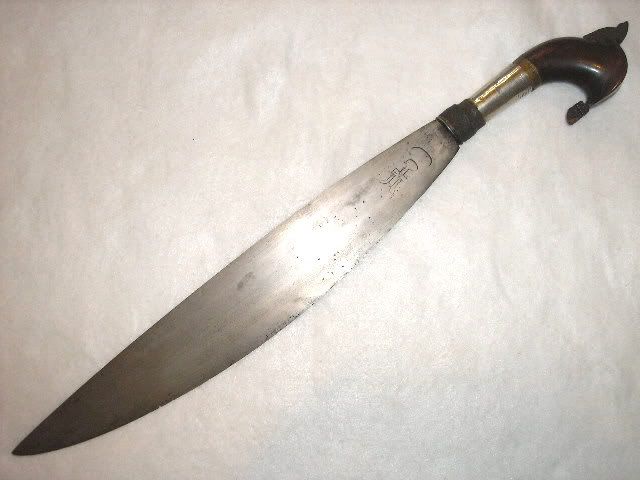 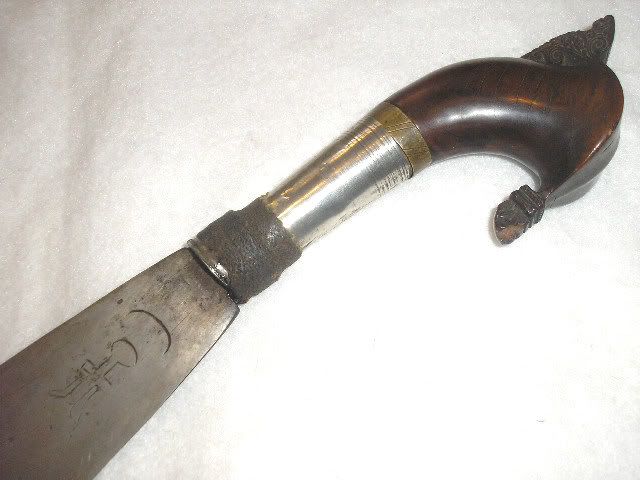 
|
|
|

|
|
|
#57 |
|
Member
Join Date: Dec 2004
Posts: 1,020
|
Spunjer, It looks like Zulfiqar, the sword of Ali. Nice Barung, give it to me for Pasko, Pare.
|
|
|

|
|
|
#58 |
|
Member
Join Date: Dec 2004
Location: Witness Protection Program
Posts: 1,730
|
yup, it is the zulfiqar. actually first barung i have that has talismanic symbol. wanna trade with some of your A-list moro stuff, p're???
 here's another one; a kampilan with talismanic symbols (trisula) running 2/3s along the spine followed by discs, and ukkil at the base of the blade on both sides. another interesting aspect is the rayskin wrap on the handle, something i've never seen on any moro weapons.  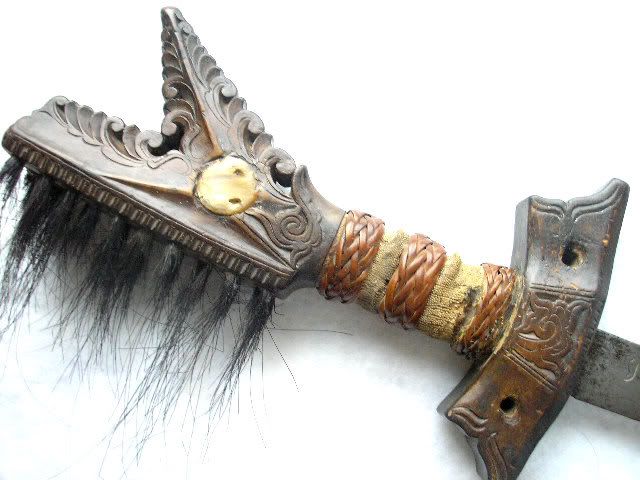 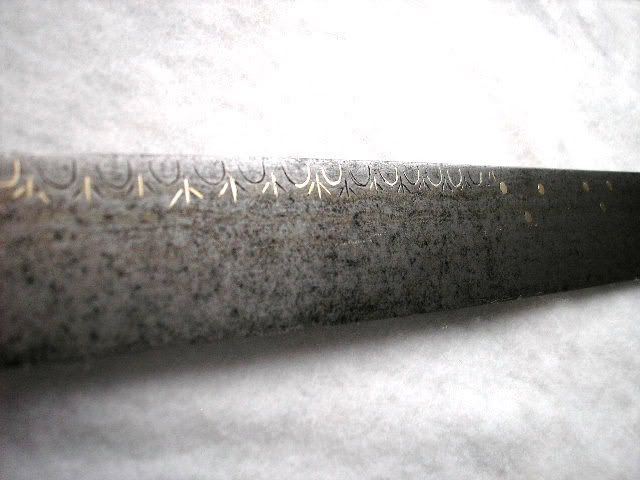
|
|
|

|
|
|
#59 |
|
Member
Join Date: Dec 2004
Location: Sweden
Posts: 1,637
|
Interesting and unusual blades!
I haven't either seen these motifs on a kampilan or a ray skin at the handle. That's strange as the sting-ray's tail, as I have been told, was quite common as a weapon all over Philippines? Michael |
|
|

|
|
|
#60 |
|
Member
Join Date: Dec 2004
Location: Witness Protection Program
Posts: 1,730
|
the stingray's tail, or buntot-pagi, are indeed used as a weapon, but it is more towards supernatural application, michael.
another less unusual, but uncommon, is the utilization of horn as croc eyes. btw, michael, do you have any other moro stuff that has talismanic symbols you don't mind sharing? |
|
|

|
 |
|
|